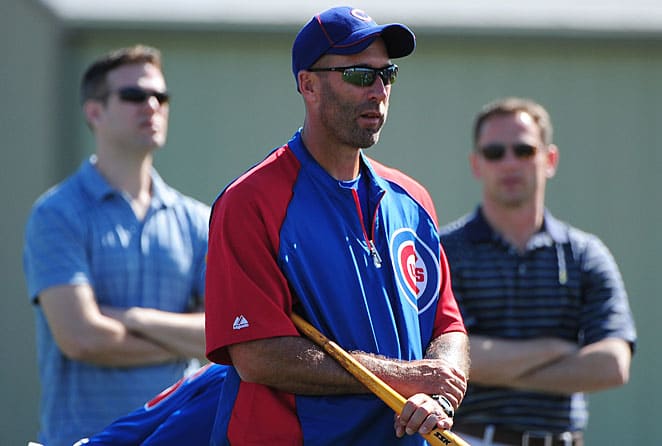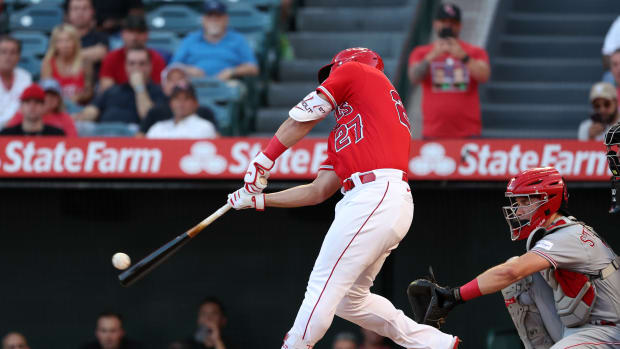In quest for depth, teams want more than just a few good men

Team president Theo Epstein, manager Dale Sveum and GM Jed Hoyer are hoping to see enough talent to get the Cubs back in contention.
/USA Today Sports
SCOTTSDALE, Ariz. -- Spring training is a time for winnowing scores of camp invitees to 40-man rosters and 25-man ballclubs, with eight- or nine-man lineups and five-man rotations. It may be a time of reduction and dismissal, but those players not included as starters on Opening Day depth charts may not be gone for long.
No team used fewer than 17 pitchers or 19 position players last season. Each organization deployed an average of 40 total players before September call-ups.
Every team will suffer injuries. Players will be demoted to the minors for ineffectiveness. Those are facts of major league baseball.
And so too is this: Opening Day rosters are organic and ever-evolving, as teams are proactive about roster permutations and manipulations in order to gain an advantage on the margins.
"It's one of the more underrated things that people don't talk about," Cubs general manager Jed Hoyer said of having depth. "Look at any preseason preview -- they are going to list off the five starters, the closer and the set-up guy and the nine guys in the lineup. But over the course of the year, [it helps] having a deep bench, having good platoons, having guys in the minor leagues that can come up when a guy gets hurt.
"The deepest teams often have the best chance to advance."
National League teams utilize the double-switch regularly and have long needed a strong bench with diverse skills, but a couple American League teams had great success last year beyond their set starters. The Orioles made 178 regular-season transactions en route to a surprise wild-card berth. The A's, another unexpected playoff entrant, beat the Rangers and Angels for the AL West while employing four daily platoons, which meant almost every position player was in the starting lineup at least a couple times per week.
This year the Rockies have said they are considering carrying eight relievers on their roster at home, where high-scoring games and bullpen attrition is the norm, but would exchange that eighth reliever for a position player on road trips where pitching depth is often less necessary.
In its 20-year history, Colorado has used 4.2 pitchers per game at Coors Field and 3.8 pitchers per game as visitors; over a 10-game homestand, that's four additional relief appearances.
"There have been some times when we go on the road, and we've got maybe too much pitching, yet we come back home and we need him," Rockies director of major league operations Bill Geivett said. "We'll look at that extra pitcher at home and what we can do on the road. That's a topic of discussion right now."
For the average fan, the identity of the 25th man on the roster of his or her favorite team is an inconsequential transaction written in eight-point font on a newspaper's agate page, but front offices spend a substantial amount of time deliberating over that final roster spot.
"More than what you would think," Giants general manager Brian Sabean said. "This year is maybe a good example of how you create depth with non-roster invites. We've got 70 people in camp. Some of that is, we have to pick a 12th pitcher. We have to decide who our extra [position] players are, whether that's a utility infielder or two or an outfielder or two, and that's got to come from this camp, from non-roster invitees or a minor league player."
At the same time, that roster spot frequently fluctuates, too, as clubs find the most value from one-tool stars such as a speedy pinch runner or versatility from well-rounded utility players who can fill a number of needs.
"Not only the 23 through 25 [on the active roster], but it really goes to 30 or 33 that are important," White Sox general manager Rick Hahn said. "No team, realistically, is blessed to get through the year with 12 pitchers. As we tell our guys, we really view it as a 15-to-18-man staff.
"It's important for the 25 men you see in Chicago on any given day to fit the way [manager Robin Ventura] needs to use them, whether it's a level of fatigue he needs to protect against or usage that he wants to stay away from with the relievers. But having those reinforcements in the minors and to be able to have some fluidity because of that is vital."
Orioles manager Buck Showalter said in an interview last May that the dividing line between the good and the great is often the last three hitters in a lineup and the last two starters in a rotation because every team has stars, but depth is paramount. That's true now more than ever, given that a record 14 clubs will have $100 million payrolls, according to Yahoo!'s projection in January.
Rangers general manager Jon Daniels gave two other reasons depth has become increasingly important, noting, "With the travel in the game and as we hopefully are getting away from the PED era, I think it's more physically challenging on players without that to fall back on. I think you need a full roster. You see it late in the season."
There are, of course, restrictions on roster maneuvering: disabled list stints are a minimum of 15 days; minor league demotions must be at least 10 days; players only have three seasons of options to freely oscillate between the majors and minors; and more subjectively, clubs often must decide whether to keep top prospects on the major league bench or stash them in Triple A where they can develop more by playing every day and delay service time to avoid Super 2 status and early free agency. Mike Trout and Bryce Harper, of course, famously were late-April additions last season.
That interleague play is more frequent this year -- there will be at least one series at all times rather than confined to a set period -- means clubs are less likely to tweak their rosters to play by the other league's rules because it's not worth sending a player down for 10 days in order to maximize performance in a two- or three-game series.
Hoyer said that when he and team president Theo Epstein worked for the Red Sox, their goal was always to construct a roster that could win 95 games, which historically gave an AL East team a great opportunity at a playoff berth. A club can feel more secure about meeting or exceeding its projection by having more depth. For bigger market teams, that can often be accomplished by stocking the bench with players making a couple million dollars. For smaller market teams, the best avenue is often using prospects who, when summoned to the majors, are only making the league minimum.
"I think that's where the young, talented teams have an advantage because they're controllable," Hoyer said. "[Those players are] on their 40-man roster. A team like Texas is a perfect example -- they're not going to have a disappointing year. They have so much depth, they've got arms and good players coming out of their ears."
Hoyer noted that most clubs have a player whom they intend to give, say, 275 plate appearances but who ends up getting 500 to fill lineup holes. For the Rangers that player may be Jurickson Profar or Mike Olt, the Nos. 1 and 22 prospects in the game, according to Baseball America.
Depth rarely gets the headlines, but as clubs prepare this spring, it's essential the practice fields at their training complexes are full of talent, too.



































